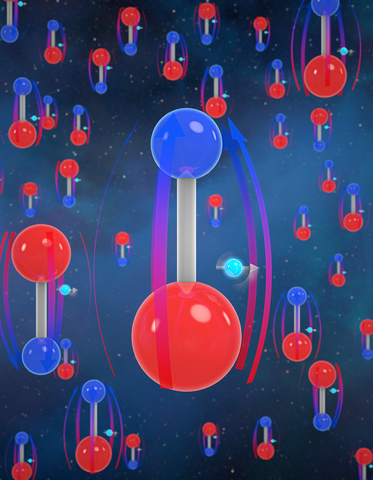2023-07-06 米国国立標準技術研究所(NIST)

Electrons are made up of a negative electrical charge, and scientists at JILA have been trying to measure how evenly that charge is spread between the north and south pole of the electron. Any unevenness would indicate that the electron is not perfectly round, and that would be evidence of an asymmetry in the early universe that led to the existence of matter. The Cornell Group at JILA studied how the electrons in molecules behaved as they adjusted the magnetic field around them to look for any shift in the electrons. Credit: JILA/Steven Burrows
◆NIST/JILAの研究チームは、電子の非対称性を調査するために実験を行いましたが、現時点では電子は円形であることが確認されました。これは宇宙の非対称性の謎を解く重要な一歩であり、高精度な測定結果は将来の研究に役立つでしょう。
<関連情報>
- https://www.nist.gov/news-events/news/2023/07/why-does-matter-exist-roundness-electrons-may-hold-clues
- https://www.science.org/doi/10.1126/science.adg4084
電子の電気双極子モーメントの改良された拘束力 An improved bound on the electron’s electric dipole moment
Tanya S. Roussy,Luke Caldwell,Trevor Wright,William B. Cairncross,Yuval Shagam,Kia Boon Ng,Noah Schlossberger,Sun Yool Park,Anzhou Wang ,Jun Ye, and Eric A. Cornell
Science Published:6 Jul 2023
DOI:https://doi.org/10.1126/science.adg4084
Editor’s summary
The puzzling imbalance between matter and antimatter in the universe can be explained by the breaking of charge parity symmetry. The standard model of particle physics does predict a slight breaking of this symmetry but is insufficient to explain the observations. Many extensions to the standard model have been proposed to resolve this discrepancy. To test such model extensions, tabletop experiments that measure the electron’s electric dipole moment (eEDM), a measure of symmetry breaking, have looked very promising. Roussy et al. exploited the large electric fields inside the polar molecular ions of hafnium fluoride to measure the eEDM to extremely high precision (see the Perspective by Fan and Jayich). The uncertainty of the measurement compares favorably to those achievable through accelerator-based experiments. —JS
Abstract
The imbalance of matter and antimatter in our Universe provides compelling motivation to search for undiscovered particles that violate charge-parity symmetry. Interactions with vacuum fluctuations of the fields associated with these new particles will induce an electric dipole moment of the electron (eEDM). We present the most precise measurement yet of the eEDM using electrons confined inside molecular ions, subjected to a huge intramolecular electric field, and evolving coherently for up to 3 seconds. Our result is consistent with zero and improves on the previous best upper bound by a factor of ~2.4. Our results provide constraints on broad classes of new physics above 1013electron volts, beyond the direct reach of the current particle colliders or those likely to be available in the coming decades.



